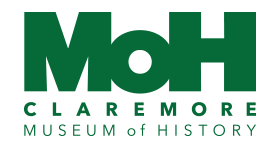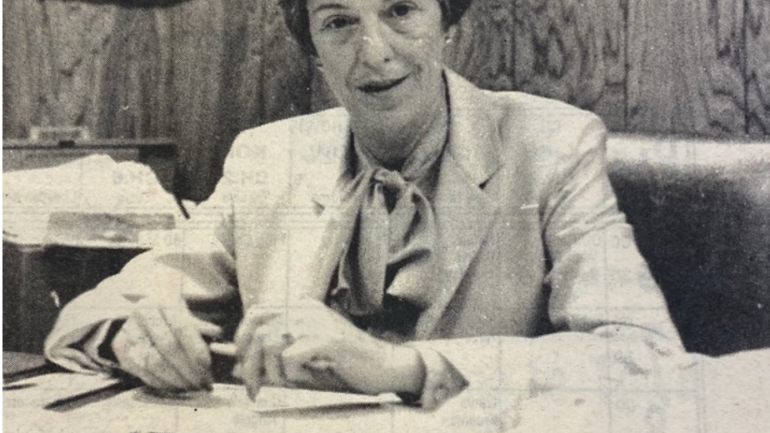Telling the history of Claremore…one story at a time
Originally published in the Claremore Daily Progress on March 22, 2008 by Larry Larkin.
.
The smell of rotten eggs is not a pleasant experience. Remember the last time you hid two dozen eggs for the little ones and they could only find 23 of them?
Best bet would be the egg behind the car bumper would be the missing one. Depending on the weather, the aroma was sure to develop over the next few weeks. It may be hard to believe now, but the community of Claremore once turned that same smell into big business. In 1903, a man named George Eaton owned the first oil company in town. One day, he was drilling for oil or gas on the east side of town. What he found instead was a water well that smelled like rotten eggs. What first appeared to be a failure turned into … pardon the pun … a golden egg, business-wise. According to legend, Eaton took the foul water and threw it into a nearby stream. A neighborhood dog, eaten up with mange, jumped into stream. Within a day or so, Eaton noticed that the dog was cured of its ailment. Eaton decided to take another look at his discovery. He had the water analyzed for medical use.
Eaton named the substance radium water. While the tests conducted actually showed it did not contain radium, the tests did reveal medicinal value. Apparently, hydrogen sulfide and sulfur were causing the smell. Claremore’s Radium Town was born. Soon, several hotels with bath houses started up at various locations and afflicted individuals started arriving by the thousands. Stomach problems, skin diseases, rheumatism or eczema, it didn’t matter. Claremore’s magic springs could cure almost any health matter. It was even a sure cure for dandruff. Word of Radium Town spread across the nation. The fast-moving fame was aided even more when Will Rogers started mentioning it in his radio programs and newspaper articles.
“Claremore, Oklahoma, greatest one-night stand health resort in the world,” he proclaimed in 1923.
A year later, he had this to say: “Now my home in Claremore, Oklahoma, the home of the best curative waters in the world, and, by the way, one of the best towns in the world to live in if any of you are thinking about making a change.”
With this type of endorsement, how could it fail? The hotels and bath houses quickly became Claremore’s biggest industry. The cure-seekers arrived by train and car loads. Tulsans came over for one-day baths while out-of-state visitors arrived for one- and two-week stays.
In addition to the bath houses, area merchants also benefited. People arriving for treatment needed to eat and shop, also.
It was during the 1930s when the Claremore Chamber of Commerce decided to get into the picture. The Chamber started holding an annual “Bath Week,” urging every Claremore citizen to take at least one radium water bath during the seven-day period.
The Chamber received half of the bath ticket sales. The revenue went to publicize the town and its radium water. The primary purpose was not to raise money as many residents thought. Officials claimed the event was to get the citizens of the city to take a bath and familiarize themselves with the “curative benefits of the water,” so that they could then “more intelligently talk” about it to strangers.
A full parade, complete with bands and floats, was staged. Of course, ol’ Will had something to say about this, as well: “We have all kinds of various ‘weeks.’ ‘Eat an apple week.’ ‘Don’t shoot your husband week.’ ‘Don’t cuss the Republicans any more than you can help week.’
“But Claremore, the home of the great radium water, is having this week one of the most practical and useful ones, ‘Take a bath week.’ Even the Rotarys, Kiwanis, Lions, Apes, and Chamber of Commerce have joined in the novelty of the thing.”
The actual site known as Radium Town is located on Ninth Street between Seminole and Dorothy streets. More than a mile from Claremore’s downtown section, the area was a small community within itself.
In addition to the bath houses, Radium Town had a laundry, a small grocery store, a cafe and a pharmacy-drug store. While the Ninth Street bath houses are now gone, two of the brick business buildings still stand. The 21-unit motel-type units on the north side of the street remain.
The Claremore Radium Wells Company bath house was the first to be built. J.S. Flippen had it constructed in 1904. It was later purchased and operated by William Jasper Perdue of Salem, Ind. It is believed the business was also known as the Claremore Health Home before becoming the Perdue Bath House.
An early day post card shows the Perdue building with a well shooting water 4 feet high beside it.
The Sanitarium Bath House was located at 601 E. Ninth St. A new well was drilled in 1905, 200 feet from the original one. It offered free taxi service to and from downtown and claimed to be the cleanest, the neatest and had the best service. Visitors were welcome to take free tours.
It later became Lacy’s Mineral Water Bath. Dr. E.E. Lacy, a local chiropractor, ran the business until his death in 1991. His parents had taken ownership of the bath house in 1948.
Today, only the foundation is left. There is no sign of the well.
Two blocks to the south was the Mendenhall Radium Water Baths. Opened in 1905, it is the only original bath house still standing. Located at the corner of Seventh Street and Lavira Avenue, the two-story building is still impressive and looks much like it did during its heyday.
Bob and Patsy Keller purchased the bath house from Watson J. Mendenhall. Becoming Keller’s Bath House, it continued the baths until 1980. Today, the building is an apartment house. It still has the Keller’s Bath House sign as a reminder of past days.
Between Mendenhall and the Kellers, the Bennett family located the Bennett Bath House there for some 44 years. Minnie Mae Bennett first came to Claremore for the bath treatments. They apparently agreed with her.
Radium Town was not the only location for treatment in Claremore.
The Bungalow Hotel and Bath House was located at 119 S. Cherokee, one block off Main Street. The two-story structure was across the street from today’s main RCB Bank building.
The Radium Bath House billed itself as “Claremore’s Finest.” Looking like the famed Roman bath houses, it was the first community-sponsored bath house and the city’s fourth overall. It cost $75,000 and was located at 323 S. Catalayah (now Lynn Riggs Boulevard). It was in operation until 1956.
Today, the J.M. Davis gun museum is at the same site.
Maybe more noted as a hotel, the Will Rogers Hotel also had a bath house. It took up an entire floor and featured modern steam cabinets, mineral water baths and a cooling room. For years, the baths were $1.50, and a massage was $1.25.
It was not unusual for 75, 80 people a day arrive for the treatments at the Will Rogers.
One of the most popular attendants at the hotel was Levi Harlin. Noted for his quiet manner, “Mr. Levi” always had a smile on his face.
Because of the hotel’s roof storage tanks, many visitors got their first whiff of Claremore’s radium water due to the hotel. The sulfur odor would usually start about two blocks away for the travelers coming through the city on U.S. 66.
Because the bus depot was right across the street, the riders also received their full dose.
Today, only the downtown hotel and the Keller building remain. The days of the radium baths are lone gone. Apparently the wells are still there. Maybe someday someone will decide to bring the radium water business back. In today’s popular health-conscious society, maybe the need is still alive. Only time will tell.
There is one more thing. What happened to the mangy dog? Can’t really say. But it was reported that he was still running around the neighborhood two years ago, however.



